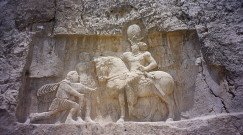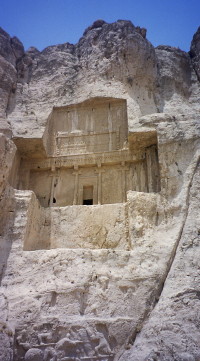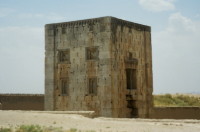
Here is the fascinating history of Iran really
in the spotlight, and there
is more to be revealed.
Photo. Tombs of Darius I
and Darius II, two of Naqsh-e Rustam great tombs.
I and my guide Ali started our excursion from Shiraz (July 2004).
First we drove to Persepolis to see the
ruins from a great ancient palace. In the history
Persepolis was the
Achaemenian capital. Soon after Darius` accession in 520 BC the building of the
palace started. So it grew to be a world wide empire. Nearby at the foot of a
rugged cliff stand some other magnificent examples of human creations: Naqsh-e Rustam - Necropolis in
Iran.
This cemetery
has become famous under the name Necropolis named by foreign researchers. It`s
because Necro means the dead and polis means city. With its grandeur and
significance of history there is something that really makes you really
excited.
Later we drove to the nearby
necropolis of Naqsh-e Rotsam, as the locals call it. This site has many tombs
and rock engravings from ancient time. As my guide told me, it would have been
better to visit Naqsh-e Rustam (Necropolis) before
Persepolis. He said that
it would be easier for me to understand the continuity of Iran`s history better,
but due to the driving distance the route we followed was more optimal.
History
The large
bas-reliefs of Naqsh-E Rustam (Necropolis) bring history alive more than any
other place in Iran
. While I wandered in the front of the tombs and rock carvings I tried
to imagine how it was for more than 2500 years ago. I wondered how
the ceremonies were at that time when the people buried their rulers. It was said
that the vultures picked the bones from the dead clean before they were stored
in the in the chambers.
Even
though Naqsh-i-Rustam had been a sacred area (as the remains of a
Pre-Achaemenid relief show) for a long time, Darius the Great was the first to
choose it as a burial place. His successors not only imitated his idea of a
cliff tomb, but also copied the layout of the tomb itself. The dramatic facade
of the tomb is constructed like a cross. An entrance leads into the tomb
chamber, cut deep into the rock.
It's impossible
for me to say how well preserved the tombs inside. Looting is still a big
problem in Iran as
other places in the world, but now it looked as the site
was well protected, and as far I could see there was some preservation work
there too.
All the four
tombs were shaped as a cross. They were constructed during the reign of each king and
they are on equal height from the original ground level.
Between tombs of
Darius I and Xerxes there is a carving from Sasanian period. It displays the
triumph of Shapur over the Romans. The king Shapur is much larger than any other
figure. Even his horse is proportionately small, not because of the Sasanians used small horses, but to
indicate the greatness of the king.
|
Photo:
Bas-relief from the Sasanian period -
triumph of Shapur (Naqsh-e Rustam, Necropolis,
Iran). |
 |
The tombs at Naqsh-E Rustam have been built
between 550 and 400 BC. The first distinct people to emerge on the Iranian
plateau were probably the Elamites, who established a city at Shush in the far
south-west. In the old days it was possible from Naqsh-e Rustam to
view the old city Estakhr.
The four tombs of this place are
believed to be those of Artaxerxes I, Xerxes I, Darius I and Darius
II (seen from left to right as you look at the
cliff). The tomb chamber is about 23 meters long and 19 meters
wide.
There are still more to find out about Naqsh-e Rustam, and historians
are still discussion several aspects and finds here.
|
Photo. Tomb of Darius II
formed as a cross as the other tombs at Naqsh-e Rustam, Necropolis,
Iran.
The tombs were constructed during the reign of
each king and they are on equal height from the original ground
level. |
 |
|
The
entrances to the tombs lead to funerary chambers where the dead kings are
buried. Unfortunately it's not possible to enter
the caves anymore, so I had to observe them from outside.
The only
creature that could go everywhere was the lizards which climbed the steep
rocky walls.
Photo. Tomb of Darius II. Tombs of Naqsh-e Rustam where large and
beautiful, but not accessible for
visitors anymore. |
 |
The Aryans came
to the region in the second millennium BC. They brought with them some
agricultural and domestic skills. It wasn't until the middle of the 6th century
BC, when the Achaemenian king Cyrus the Great ruled the region, that Persian
history was documented. The Achaemenian Dynasty is recognised as the founder of
the Persian Empire that later become Iran. The
Sasanian dynasty started with Ardeshir I in 220 AD, and used the site for
propaganda purposes so they could increase their power.
The kings from
the period were forgotten in Islamic times. So was also the purpose of the
place. People assumed the reliefs were from Ferdowsi's epic, the Shahnameh,
connected the rock carvings to the hero Rostam.
Mysterious building
beside
One great mystery on the place is
the square stone building called Cube of Zoroaster (Kabeh-e Zarthusht). It stands approximately
50 metres back from the rock-face opposite the tomb of Artaxerxes I (the tomb to
the left when you look at the cliff).
Many theories
have been launch about this building. Despite the walls display inscriptions of
Sassanian victories, the building is believed to be an Achaemenid fire temple.
The reason for this is that similar buildings have been shown on coins of a
later period. On these coins there have been depicted roof with fire altars with
flames on the top.
|
Photo. Kabeh-e Zarthusht (Cube of Zoroaster), Naqsh-e
Rustam. This building is still a mystery. Is it connected to
religion? |
 |
Cube of
Zoroaster was constructed so that the light of the sacred fire could keep the
carvings and the tombs illuminated.
The kings and dynasties in
the region are gone, but the well preserved monuments make the history live. The
magnificent Naqsh-e Rustam has been excavated and explored for many years
now, but still there are more
to find out about the past at the site an in the region. Just as a new day
begins the history has to be updated continually based on new
knowledge and experiences.
Stein Morten Lund,
15 August
2004
Additional
information
Especially
thanks to my excellent guide Ali Hussein Manoochehri (from Pars Tourist
Agency (P.T.A), Shiraz,
Iran - www.key2persia.com) who contributed with
information and translation.
Tour
information visiting ancient monuments as mentioned in this article:
Attractions:
1.
Persepolis (2 hours)
2. Necropolis (1
hour)
3. Naqshe Rajab
(20 min)
4.
Istakhr
City (20 min)
5.
Pasargadae (1.30 hour)
Itinerary:
All ancient
highlights in one day: move from Shiraz to
Persepolis (53km, 1
hour) in the morning 2 hours for visiting Persepolis, move to
Necropolis (8km), 1 hour for visiting Necropolis. Move to Naqshe Rajab (3km),
visiting the relieves there, having lunch at a restaurant, move to Pasargadae
(79km), on the way visit Istakhr City and then return to Shiraz (2 hours).
Approximate tour duration: 8 hours.
****************************************************************************************************************
Pars
Tourist Agency (P.T.A.), Iran
Presentation:
It`s a
private Persian incoming agency. It's located in Shiraz under the license
number 1/47026 issued by Iran Travel & Tourism Organization (ITTO) (www.farstourism.org). They organise a wide
variety of tours for individuals as well as groups such as inbound historical,
cultural, anthropology, mountaineering, trekking, adventure and natural
excursion tours.
Speciality - exploring nomad tribes:
For real adventurers P.T.A.
arranges expeditions in to rural areas to search for nomad tribes in Iran's high
mountains. Some of the tribes are Bakhtiari, Lor, Qashqai. They live in a
beautiful landscape that will take your breath away. You will be able to explore
the tribe's daily life and unique culture in a natural way. Sometimes you will
experience a wedding, birth, fighting game, dancing, festival or other things.
Take your time and see what happens. Then it will be an experience of a
lifetime.
Contact info:
Phone: 0098-711-2223163 and 0098-711-2240645. Mobile
Phone (around the clock) 0098-9171118514.
Fax: 0098-711-2229693
Letters:
Pars Tourist Agency (P.T.A), Zand Street 71358, Next to Iran Cinema, Shiraz,
Iran.
Website: www.key2persia.com
E-mail: info@key2persia.com
****************************************************************************************************************
